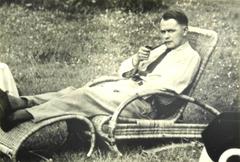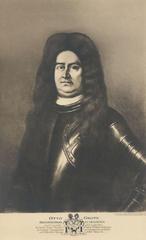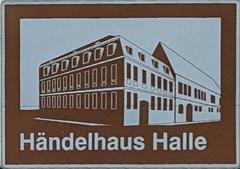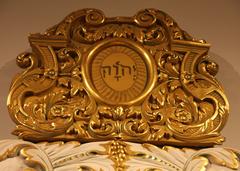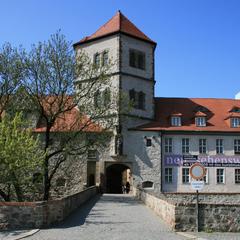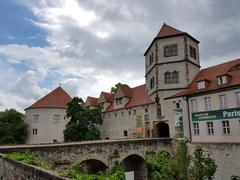
St. Moritz Church, Halle, Germany: Visiting Hours, Tickets, and Historical Significance
Date: 04/07/2025
Introduction
St. Moritz Church (Moritzkirche) in Halle (Saale), Germany, stands as a compelling monument to the city’s medieval origins, religious shifts, and artistic achievements. As one of Halle’s oldest churches, Moritzkirche offers visitors a tangible connection to the city’s Romanesque beginnings, its late-Gothic architectural transformation, and its enduring role in local culture. The church’s evolution from a simple 12th-century chapel to a masterpiece of late-Gothic design by Conrad von Einbeck mirrors the broader spiritual and social developments of Halle, particularly its ties to the influential salt industry and its pivotal place during the Reformation.
Situated adjacent to the historic Hallmarkt and medieval city walls, St. Moritz Church remains a vibrant center for worship, music, and community life. The church is readily accessible on foot from Halle’s central train station or via public transport, welcomes visitors free of charge, and regularly offers guided tours by appointment. This guide provides a thorough overview of St. Moritz Church’s history, architectural highlights, practical visiting information, and its place within the broader context of Halle’s cultural heritage.
For up-to-date details and resources, consult the St. Moritz Church website, Halle Tourism, and Halle im Bild.
Table of Contents
- Introduction
- Historical Overview
- Architectural Highlights
- Artistic and Cultural Significance
- Urban Context and Nearby Attractions
- Visitor Information
- Tips for Your Visit
- Frequently Asked Questions (FAQ)
- Conclusion
- References
Historical Overview
Romanesque Origins
St. Moritz Church began as a modest Romanesque chapel in the early 12th century, dedicated to St. Maurice. By 1141, it had been expanded to serve as the parish church for the southern Old Town and became closely associated with the Halloren, Halle’s historic salt workers. In 1184, the church was elevated to the status of a collegiate church of the Augustinian Canons, underscoring its growing religious weight within the city.
Gothic Transformation
Between 1388 and 1411, the church underwent a major transformation under master builder Conrad von Einbeck, becoming one of the region’s earliest examples of a late-Gothic hall church (Hallenkirche). Notable features include the expansive eastern choir with large traceried windows, which flood the interior with light—an innovation for its time and region. Although the planned western tower was never completed, the church’s design had a lasting influence, serving as a model for subsequent churches in Saxony.
The Reformation and Beyond
St. Moritz Church played a vital role in Halle’s religious evolution during the Reformation. It hosted Halle’s first Protestant service in 1542 and became the setting for Justus Jonas’s influential church order. Over the centuries, the church adapted to various liturgical and social changes, including a Baroque period marked by a now-lost tower, before returning to its Catholic roots in the 20th century. Today, it serves the parish of “St. Mauritius und St. Elisabeth” and the Catholic Student Community.
Architectural Highlights
St. Moritz Church is celebrated as a hallmark of late-Gothic architecture. Its three-aisled hall design, ribbed vaults, and intricate eastern choir stonework display the era’s craftsmanship. The church’s light-filled nave, supported by slender pillars, and the surviving late-Gothic sculptures—many signed and dated—offer unique insights into medieval artistry. The 16th-century high altar and a renowned 1925 organ further enhance the church’s artistic legacy (Halle im Bild).
Artistic and Cultural Significance
Beyond its architectural merits, St. Moritz Church is a repository of religious art. Highlights include late-Gothic stone sculptures and the early 16th-century high altar, which have survived centuries of change. The church’s exceptional organ, dating from 1925, is a centerpiece for concerts and liturgical music, reinforcing Moritzkirche’s status as a living cultural venue.
Urban Context and Nearby Attractions
St. Moritz Church is located within Halle’s historic center, adjacent to the Hallmarkt and the remnants of medieval fortifications. Its proximity to the former St. Johannis Hospital and other key landmarks reflects the church’s importance in community life and urban development. After visiting Moritzkirche, explore nearby sites such as the Marktkirche Unser Lieben Frauen, the Francke Foundations, and Halle’s atmospheric Old Town.
Visitor Information
Opening Hours
- Tuesday to Sunday: 10:00 AM – 5:00 PM
- Monday: Closed
- Note: Hours may vary during holidays, special events, or concerts. It’s advisable to check the official website for current information.
Tickets and Donations
- Admission: Free entry
- Donations: Voluntary donations are appreciated to support ongoing preservation efforts.
Accessibility
- Wheelchair Access: Available at main entrances, though some historic areas may be less accessible due to the church’s architecture.
- Assistance: Staff can provide support upon request.
Guided Tours
- Availability: Guided tours are offered on weekends or by prior appointment. Contact the Halle tourism office or the parish for arrangements.
Tips for Your Visit
- Getting There: St. Moritz Church is a 15-minute walk from Halle Hauptbahnhof. Public transport, including buses and trams, stop nearby.
- Photography: Outdoor photography is encouraged. For interior photography, inquire about permissions, especially during services.
- Combine with Other Sights: Plan your visit alongside other Halle landmarks like the Handel House Museum and the State Museum of Prehistory.
- Events: Check for concerts or special exhibitions that coincide with your visit for a richer experience.
Frequently Asked Questions (FAQ)
Q: Is there an entrance fee for St. Moritz Church?
A: No, entry is free. Donations to support the church are welcome.
Q: Are guided tours available?
A: Yes, usually on weekends or by appointment. Tours provide valuable insights into the church’s history and architecture.
Q: Is St. Moritz Church wheelchair accessible?
A: Yes, main areas are accessible, though some historic sections may have limitations.
Q: Can I attend a church service?
A: Yes, regular Catholic services are held. Check the parish website for schedules.
Q: How do I get to St. Moritz Church using public transport?
A: The church is easily reachable via city trams and buses, with stops close to Hallmarkt.
Conclusion
St. Moritz Church in Halle seamlessly blends centuries of religious, architectural, and social history into one exceptional visitor experience. From its Romanesque roots and late-Gothic hall church design to its ongoing role as a hub for worship and music, Moritzkirche is both a historic treasure and a living part of Halle’s community. Whether exploring its luminous nave, admiring medieval sculptures, or attending a concert, visitors will find St. Moritz Church a highlight of Halle’s cultural landscape.
For comprehensive planning and the latest information, please visit the St. Moritz Church website, Halle Tourism, and Halle im Bild.
References
- Visiting St. Moritz Church Halle: History, Tickets, Hours & Travel Tips, 2025, Halle Tourism (https://www.halle.de)
- Visiting St. Moritz Church in Halle, Germany: Architecture, History, and Visitor Information, 2025, Halle im Bild (https://www.halle-im-bild.de/fotos/gotteshaeuser/st-moritz)
- Cultural and Religious Importance, 2025, Halle Tourist Information (https://halle-touristinformation.de/)
- St. Moritz Visiting Hours, Tickets, and Top Things to Do in Switzerland’s Alpine Gem, 2025, Swiss Activities and Wanderlog (https://www.stmoritz.com/en)





